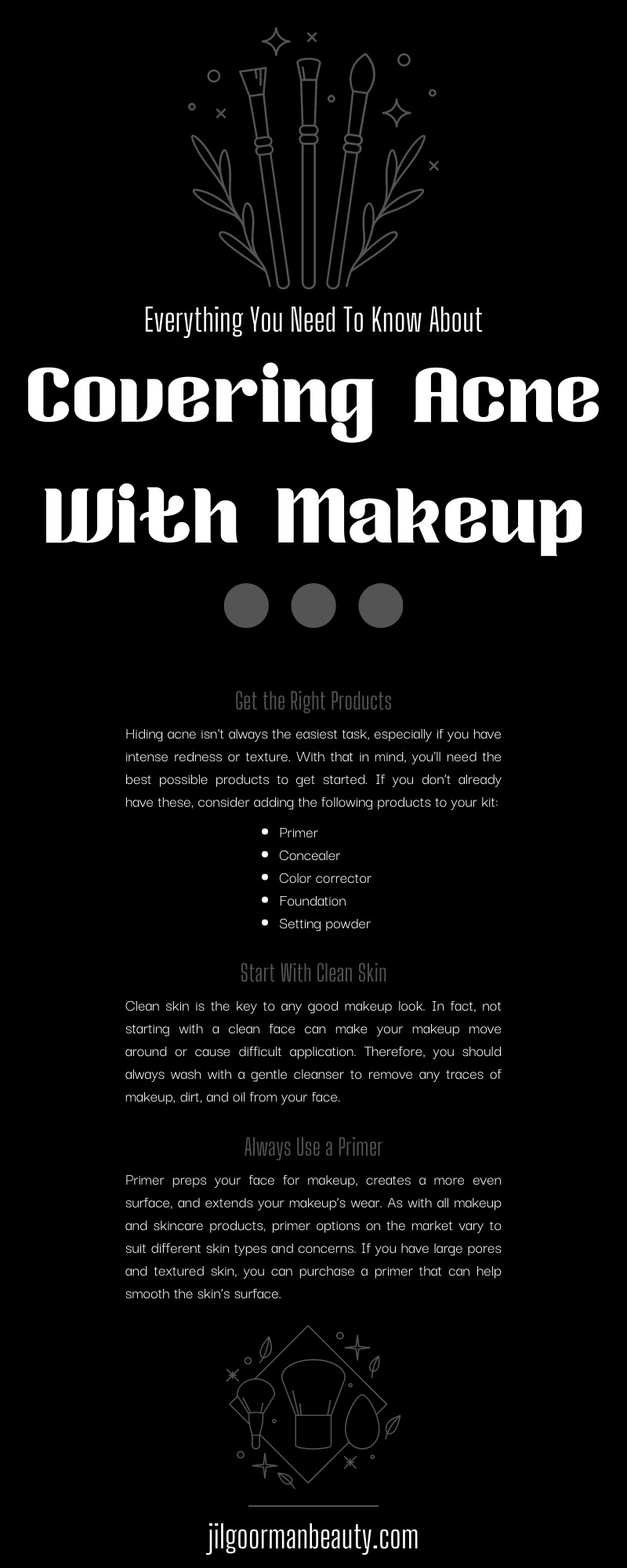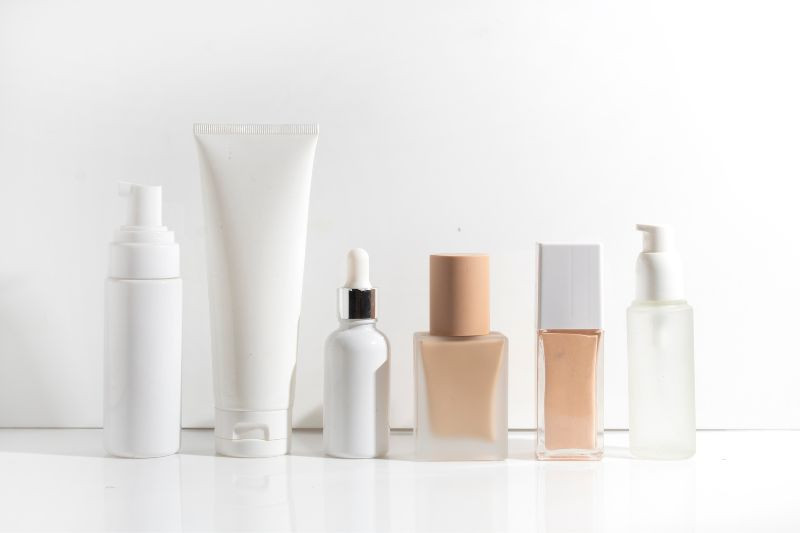You may think acne only impacts you during your teenage years, but that’s not always the case. Whether you suffer from chronic acne or the occasional breakout, it can halt your confidence and make you want to stay home forever. Breakouts always seem to pop up right before a major photo-worthy event. Don’t let acne stop you from living life. Instead, discover everything you need to know about covering acne with makeup if you’re uncomfortable with your skin condition.
Get the Right Products
Hiding acne isn’t always the easiest task, especially if you have intense redness or texture. With that in mind, you’ll need the best possible products to get started. If you don’t already have these, consider adding the following products to your kit:
- Primer
- Concealer
- Color corrector
- Foundation
- Setting powder
Once you have these, you’re ready to get down to business. Although it may seem like a lot of makeup, you will need each unique product to do a specific job for your skin. If you have acne-prone skin, you should consider investing in acne-safe makeup. Usually, the packaging states “non-comedogenic” or “non-acnegenic,” meaning it won’t cause acne or clog your pores.
Start With Clean Skin
Clean skin is the key to any good makeup look. In fact, not starting with a clean face can make your makeup move around or cause difficult application. Therefore, you should always wash with a gentle cleanser to remove any traces of makeup, dirt, and oil from your face. Afterward, you can continue with your normal daytime skincare regimen—including toner, acne treatment, sunscreen, moisturizer, etc.
While it may seem as though you already have a thick layer of product on your skin after completing your skincare routine, it’s essential to provide sun protection and adequate hydration for healing skin. Remember to let your face dry before moving on to your makeup application.
Always Use a Primer
Primer preps your face for makeup, creates a more even surface, and extends your makeup’s wear. As with all makeup and skincare products, primer options on the market vary to suit different skin types and concerns. If you have large pores and textured skin, you can purchase a primer that can help smooth the skin’s surface.
Simply use your fingers or a makeup sponge to spread a pea-sized dollop of primer around your entire face, avoiding your eyes. Give it a few minutes to dry before applying additional products.
Use a Color-Correcting Product
After your primer dries, you can use a color-correcting product to help reduce the appearance of breakouts and blemishes. For instance, a green color-corrector can help conceal red breakouts or acne marks. While yellow or peach color-correctors are best for brown or purple acne marks.
To apply, use your finger to gently dab each blemish or mark with the product until it blends into your skin.
Decide What Type of Acne You Have
Because there are different types of acne and breakouts, knowing which type you have can help you properly cover it with makeup. Interestingly, one coverage technique may work for one acne type but not another. Follow along to determine which description fits your current skin condition:
- Blackheads: Appear as dark, clogged pores. It may look and feel like the skin of a strawberry and typically occurs on the nose or chin.
- Whiteheads: A small bump with a white center. It may be red on the edges and contain fluid.
- Cystic Acne: Big red bumps or bulges underneath the skin’s surface. This type is typically more painful than others.
- Hormonal Acne: Any type of acne that typically occurs around your chin and jawline at least once a month.
- Texture and Acne Scars: This may appear as discoloration or marks with a normal or abnormal skin texture. Typically, the skin will have indents, giving it the look and feel of an orange peel.
Now that you know which type of acne you have, it’s time to learn how to cover it! You shouldn’t let your skin imperfections keep you from attending events or spending time outside your home.
How To Cover Each Unique Acne Type
Covering acne looks different depending on the specific type. Unfortunately, covering your acne doesn’t treat or fix it. However, it can help you feel more confident in your own skin until your breakouts heal.
Blackheads
Fortunately, blackheads aren’t entirely difficult to cover. Follow these steps for a flawless finish!
- Use a primer that soothes and takes away the appearance of dry, flaky skin.
- Apply a medium-coverage foundation; a full-coverage option may enhance the appearance of your blackheads.
- Use a fluffy brush to move the product around and thin out the layer of makeup. Apply a small dollop of a similar-colored concealer for extra coverage.
- Finish by dusting your face with powder foundation or translucent setting powder.
Whiteheads
Whiteheads are one of the most frustrating acne types, but you can still cover them. Be careful not to pop them during your makeup application.
- Apply a spot treatment cream that contains salicylic acid or benzoyl peroxide to help the pimple heal.
- Use a green color-corrector to reduce redness and discoloration.
- Dab a small amount of concealer on the blemish using your fingers or a small brush.
- Apply medium-coverage liquid foundation, and blend it using a fluffy brush or a blending sponge.
- Finish by dusting your face with powder foundation or translucent setting powder.
Cystic Acne
Cystic acne can be painful and difficult to eliminate; don’t worry, you can still get a flawless finish!
- Apply primer,then a green color-corrector to reduce redness and discoloration.
- Use a small amount of full-coverage foundation on top of your blemishes and blend with a sponge.
- Dab some concealer on the spots where more coverage may be needed.
- Gently press powder foundation or translucent setting powder into your skin.
Hormonal Acne
Hormonal acne can happen at almost any age, but you shouldn’t feel ashamed. Follow along to get a perfect finish.
- Apply a water-based primer.
- Use a green color-corrector to reduce the appearance of redness and other discoloration.
- Dab concealer on and around your blemishes with your fingers.
- Apply a medium-coverage foundation with a large brush using circular motions. Use more concealer if you want extra coverage.
- Finish by dusting your face with powder foundation or translucent setting powder.
Texture and Acne Scars
Texture and scars come from past acne and may stay for a while. Fortunately, you can cover them with makeup.
- Apply a water-based primer.
- Use a purple color-corrector for any dark acne marks.
- Dab concealer onto your face using your fingers. Use a tissue to dab off any excess product.
- Apply a full-coverage foundation using a stippling brush to create an even look.
- Finish by dusting your face with translucent setting powder.
Tips for Preventing Breakouts
- Remove your makeup completely.
- Use a new washcloth daily.
- Clean your makeup brushes.
- Care for your skin—inside and out.
Breakouts aren’t the end of the world, but they can impact your spirit. Hopefully, you learned everything you need to know about covering acne with makeup. Adequate coverage can restore your skin’s vibrance and your overall confidence.


